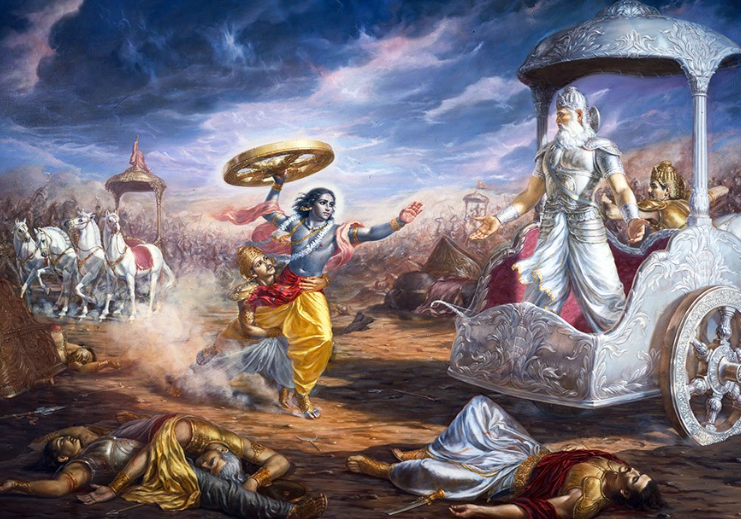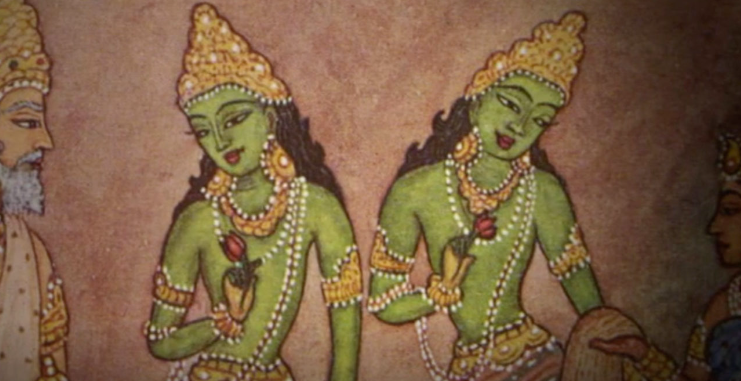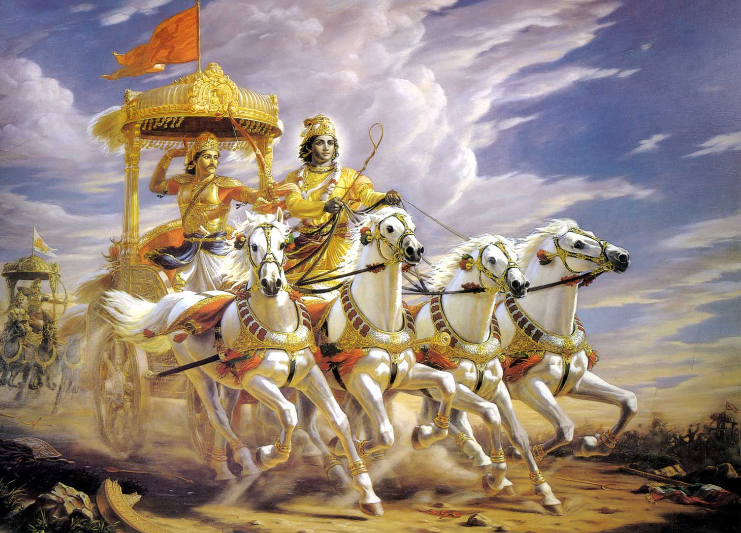Bhagavad Gita is a Yogic text in Hinduism and is written in the Sanskrit language. Composed around 1st or 2nd century BCE, it is commonly referred to as Gita. It is comprising 700 verses from chapters 23 to 40 of the great book—Mahabharata. It takes the form of conversation and dialogues between two Krishna (an avatar of Lord Vishnu) and Prince Arjun.
The word “Bhagavad Gita” means “song of God” in the Sanskrit language.
It acquaints us with the concept of death. Krishna teaches us that only the body can die or be killed, while the soul remains immortal; the soul is reborn in another body after one’s death. Its inner or true meaning refers to the freedom from the cycle of rebirth. It talks about the concepts of moksha (salvation) and nirvana (extinction).
Bhagavad Gita —The Story:
Arjuna, all of a sudden, is overwhelmed at the periphery of the Dharma Yuddha, the righteous battle between Pandavas and Kauravas, the members of the same family. He feels depressed about the misgivings of the justice of killings that would happen around him, knowing the fact that many of them are his own relatives and friends. He expresses his emotional dilemma and worries to Krishna, who is his charioteer. Thus, the answers provided by Krishna were the central theme of the Bhagavad gita.
Krishna makes Arjuna realize that he belongs to a great class of warriors and he should perform his Kshatriya duty and justify “dharma through karma”, his selfless actions. And then the war commences.
A part of Prasthanatrayi, Bhagavadgita includes Upanishads and Brahma Sutras. The basic teachings of the Upanishads, from the speculative compilations between 1000 and 600 BCE and the philosophy of Samkhya Yoga (based on the concepts of mind-body dualism), are visible in the arguments presented by Krishna in the Bhagavadgita. He stresses the concept of the immortality of the soul and its transmigration into another body after death. For those who understand the real meaning of this, achieve salvation that is Moksha, or extinction that is Nirvana from the rebirth cycle.
Krishna guides on the path of Bhakti (devotion) as the solution to resolve the conflict between the Vedic injunction to sacrifice and to gather a record of good deeds (karma) and the Upanishadic injunction to meditate and accumulate Jnana, that is knowledge. Some Hindus give Gita the status of Upanishads, while some others consider it as an important Smriti.
Krishna transforms into his doomsday avatar (form)— a fiery gaping mouth, swallowing all the creatures in the universe at the end of the day when he is asked by Arjuna to reveal his true cosmic nature. But the moral deadlock is not much resolved as destroyed.
In between this deadly scenario, Arjuna apologized to Krishna for his periodic misbehavior. He asks for forgiveness for the times he casually called him out as a friend. He pleads to Krishna to return to his previous form. The gods consented to do so, resuming his old human avatar, and a close companion of Arjuna, the warrior.
The dialogues between Arjuna and Krishna cover a broad spectrum of spiritual topics. It stresses many philosophical and ethical issues that go around the war and even beyond the existence of that great battle.
The Chapters
There are a total of 18 chapters in the epic Mahabharata, which comprise the great poetic story—Bhagavadgita.
Chapter 1: Arjuna Vishada Yoga—The Distress of Arjuna (47 verses)
The first chapter describes the inner dilemmas which prevail in Arjuna’s mind before the great battle commences. Arjuna questions the morality of the war to Krishna as he feels that the war is devastating and will kill many of his close ones too. He asks if it would be noble to leave the battlefield before the war starts, or if he should be part of the war.
Chapter 2: Sankhya Yoga— Self-realisation (72 verses)
The teachings and the philosophical discussions in Gita begin with this chapter. The Hindu ideas and beliefs of rebirth, samsara, self, universal self, inner divinity, types of yoga, the nature of self-knowledge, and similar concepts form the basis of discussion in this chapter. The Samkhya and Yoga schools of Hindu Philosophy are reflected in the ideas discussed in this chapter. Chapter 2 is an overview of the remaining 16 chapters of the Gita.
Chapter 3: Karma Yoga—Selfless Service (43 verses)
In this chapter, Krishna guides Arjuna towards his obligations and performance of his duty—dharma. He explains to Arjuna that every cause has some effect, which may be either good or bad. These are the karmic effects, and those who act without yearning for the fruits are free from these karmic influences. Without getting bothered by the external world, happiness for such beings comes from within. This chapter showcases the theological response to Arjuna’s dilemmas.
Chapter 4: Gyana Karma Sanyasa Yoga —Wisdom In Action (42 verses)
Arjuna is puzzled when Krishna reveals to him that he had taught this yoga to the Vedic sages. As Krishna was born in this age, while those sages lived long ago, Arjuna asks him how he could teach this yoga to them. Krishna explains the cycle of rebirth, the establishment of dharma, and spiritual awareness gained by selfless actions. This chapter marks the beginning of the revelation of Krishna’s divine nature to Arjuna.
Chapter 5: Karma Sanyasa Yoga —Renounce and Rejoice (29 verses)
This chapter begins with the topic of the life of sannyasa(monks) and the grihastha (householders) and the tension prevailing in the Indian tradition between the two. Arjuna wants to know which path is better, to which Krishna explains that the path of selfless action and service with inner repudiation is better. The importance of self-awareness is explained in the last verses, wherein said self-realization leads to a life that is free of anger, fear, or any desire.
Chapter 6: Dhyana Yoga —The Practice of Meditation (47 Verses)
This chapter discusses the principles of Yoga and meditation, and who a true yogi is. It further emphasizes what is required to reach the state where one harbors no hatefulness towards anyone or anything.
Chapter 7: Gyana Vigyana Yoga — Wisdom From Realization (30 Verses)
This chapter explains that evil is the outcome of ignorance and attachment to the impermanent, which is delusive Maya. It stresses the aspect of Self as the highest goal of any spiritual pursuit, which equates to self-knowledge and the union with Krishna.
Chapter 8: Akshara Brahma Yoga —The Eternal Godhead (28 verses)
This chapter states the “science of last things,” which is a theological aspect consisting of death, judgment, and the final destination of the soul and the human body. The chapter talks about the difference between the material and spiritual world, the importance of the last thought before one’s death, and describes the light and dark paths taken by a Self after death.
Chapter 9: Raja Vidya Raja Guhya Yoga —The Royal Path (34 Verses)
In this chapter, Krishna describes himself as the father and mother of the universe, to be the OM, to the three Vedas, to the seed, the goal of life, and the refuge and abode of all. Thus this chapter defines His supremacy and preaches the devotional worship of Krishna.
Chapter 10: Vibhuti Yoga—Divine Splendour (42 Verses)
In this chapter, Krishna represents himself in front of Arjuna as the supreme being. He describes himself as the “atman” in all beings. He is Arjuna’s innermost Self, the compassionate Vishnu, also Surya, Indra, Shiv Rudra, Yama, Ananta, and also Om. He is time, Gayatri mantra, Vedic sages, and also the science of self-knowledge. Arjuna thereby accepts Krishna as the Purushottama—the supreme being.
Chapter 11: Vishvarupa Darshana Yoga —The Cosmic Vision (55 Verses)
“Vishvarupa” refers to the universal form that Krishna exhibited on Arjuna’s requests. In this chapter, as Arjuna gets an understanding of Krishna, Arjuna first enters into savikalpa samadhi —particular, and then into nirvikalpa samadhi— universal.
Chapter 12: Bhakti Yoga—The Way Of Love (20 Verses)
This chapter describes the presence of the easier path for most humans for identifying and loving God either in humans or any other form. Krishna says in the last 8 verses of the chapter, that he loves those who —
- • have compassion for all living beings,
- • stay contented with whatever they have,
- • live an impartial and selfless life,
- • stay unaffected by transient pain or pleasure
- • has no craving for praise and no depression from criticism
Chapter 13: Kshetra Kshetrajna Vibhaga Yoga —The Field And The Knower (34 Verses)
In this chapter, Krishna explains the difference between the transient perishable body (kshetra) and the perpetual eternal Self (kshetrajna). This chapter redefines the battlefield as the human body, the material environment in which a being struggles to know oneself.
Chapter 14: Gunatraya Vibhaga Yoga —The Forces Of Evolution (27 Verses)
In this chapter, Krishna explains the difference between Purusha and Prakriti, by linking human experiences to the three Gunas (qualities) —sattva, rajas, and tamas. The Gunas, as described, affect the ego but not the Self.
Chapter 15: Purushottama Yoga—The Supreme Self (20 Verses)
Krishna, in this chapter, discusses the nature of God, where he not only transcends the impermanent body but also transcends the Atman (Self) in every living being.
Chapter 16: Daivasura Sampad Vibhaga Yoga —Two Paths (24 Verses)
This chapter states two types of human nature, where one leads to happiness and the other towards suffering. Krishna explains these two human traits as DIVINE—consisting of virtues like truthfulness, sincerity, love for others, self-restraint, compassion, fairness, being detached, avoiding anger, and DEMONIC—which is marked by vices like conceit, hypocrisy, and cruelty.
Chapter 17: Shraddhatraya Vibhaga Yoga —The Power Of Faith (28 Verses)
In this chapter, Krishna approves and explains the three divisions of Faith, thoughts, deeds, and even eating habits to correspond to the three Gunas or modes.
Chapter 18: Moksha Sanyasa Yoga —Freedom And Renunciation (78 Verses)
This is the last chapter in Bhagavad gita that summarizes the teachings of all the previous chapters. This chapter once again emphasizes the “phala-tyaga teaching,” which teaches us to act without craving the fruits or rewards for our actions.

Bhagavad Gita —The 5 Basic Truths
The Bhagavad gita consists of 5 main topics which express the essence and totality of this great text.
- Ishvara —God In the Gita, Krishna declares that He is the ultimate proprietor, controller, and enjoyer of everything in the universe. He is the source of all spiritual and material worlds, every animate and inanimate objects are a manifestation of His energies. He is the super soul residing in every living entity, and only pure devotion towards Him can lead oneself to Goloka Vrindavana, His supreme abode.The Gita clearly describes God as a supreme form of energy, that is neither abstract nor impersonal. God is but Krishna, in the human avatar. Bhagavadgita glorifies the relationship between Krishna and His devotees, their u conditional service towards Him, and His affectionate reciprocation toward them.
- Jeeva—Living Entity Krishna explains in the Gita, that we are not material bodies, but spirit souls. Our bodies will be destroyed soon, but our spirits are indestructible. Though the soul can’t be seen, it can be perceived or felt. It simply reincarnates from one body form to another.Krishna explains that every living entity is His part, and He is the supreme whole. And our ignorance towards this truth of life is the whole cause of our sufferings.
- Prakriti—Nature Nature is considered to be our mother who nourished us with everything necessary for our sustenance. Lord Krishna declares that Mother Nature is working under His commands and directions. Nature controls every living entity through the three principles—goodness, passion, and ignorance.
- Kala —Time It is explained in the Gita that “time” is relative and cyclical. A set of four yugas—Satya, Treta, Dwapara, and Kali repeat themselves in a cyclic pattern. One day of Brahma consists of 1000 such cycles, and 1000 cycles make one night. And 100 years of Brahma’s lifetime is the lifetime of this universe. After this, the universe will be destroyed and recreated.
- Karma—Action Karma is the most discussed subject in the Gita, which refers to the duty that liberates us from the influence of ignorance. Ignorance of our relationship with God leads to our suffering. This relationship can once again be established by practicing “yoga”. Bhagavadgita describes various types of yogas:
- • Karma yoga—the path of action toward the Supreme
- • Jnana yoga—the path of knowledge about the Supreme
- • Dhyana yoga—the path of meditation of the Supreme
- • Bhakti yoga—the path of devotion and service unto the Supreme
Further, Bhakti yoga is believed to be the direct, easiest, and quickest path to reach the Supreme power —lord Krishna.

Bhagavad Gita—Influence & Popularity
The holy book of Gita is considered to be pious and the true source of spiritual guidance by many Hindus. It is one of the most influential religious scriptures for Hindus. It achieved new prominence in the 19th century during the British rule in India, when it was lauded as the Hindu equivalent of the New Testament and when the American philosopher Ralph Waldo Emerson and Henry David Thoreau considered the Gita as the significant Hindu text. According to Gerald James Larson, who is an Indologist and a classical Hindu Philosophies Scholar, “if there is any one text that comes near to embodying the totality of what it is to be a Hindu, it would be the Bhagavad Gita.”
Even Mahatma Gandhi wrote a commentary on Gita, as he considered it to be a crucial text. Many other commentaries are written on Bhagavadgita, with a variety of views according to one’s understanding. According to a few, Bhagavadgita is written by lord Ganesha, as narrated to him by Veda Vyasa.
Bhagavadgita has got a unique influence on Hindu beliefs and spirituality, being one of the most popular Hindu Texts of all time. Gita is a great synthesis of Hindu ideas about various aspects of life. It consists of propositions about dharma, Bhakti, yogic ideals, and beliefs based on principles of moksha.
The Bhagavad Gita has not only been an influential and highly praiseworthy script by various prominent Indian leaders like Mahatma Gandhi and Sarvepalli Radhakrishnan but has been much appreciated and referred by famous personalities like Henry David Thoreau, Ralph Waldo Emerson, Aldous Huxley, Carl Jung and many more.
By sincere reading of Bhagavad Gita, it true understanding and application in life, a person can aim to become a humble human in one’s dealing in this material world. All goodness is attracted to this person, and he becomes successful in all his relationships. He can thus stay happy in worldly life, and thereafter.
Interested in becoming a yoga teacher?
Newsletter
Upcoming events and latest blogs
